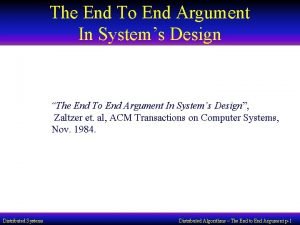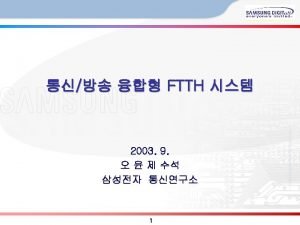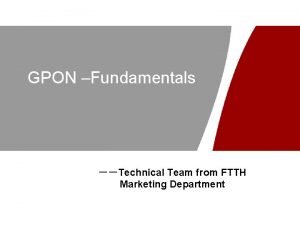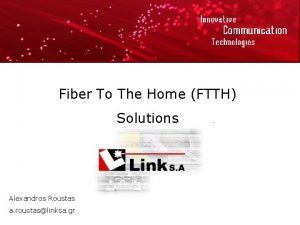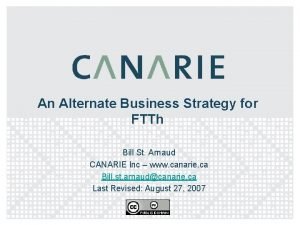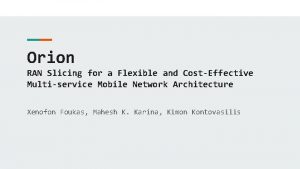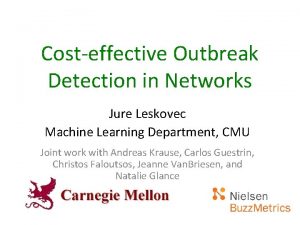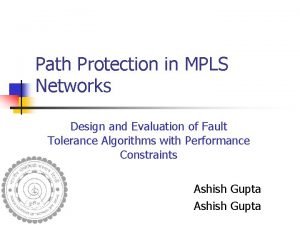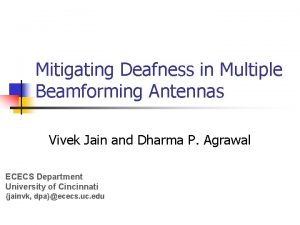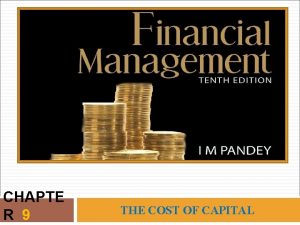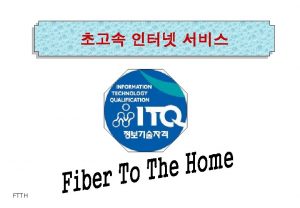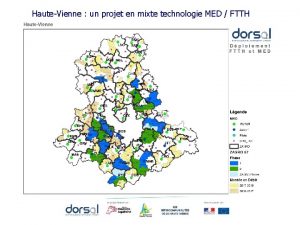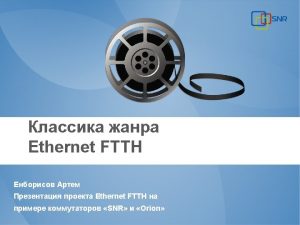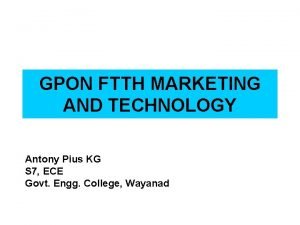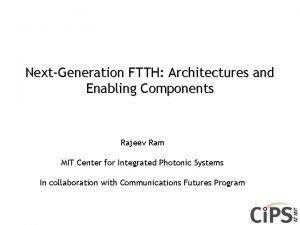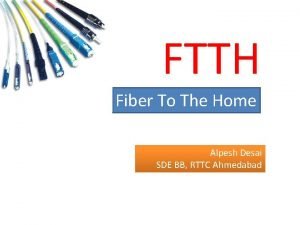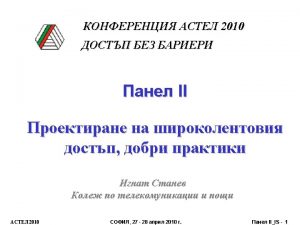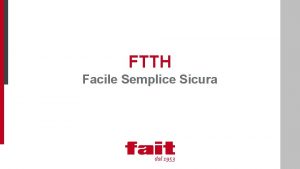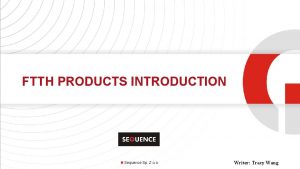Perfecting FTTH Cost Effective Design with the End






























- Slides: 30

Perfecting FTTH: Cost Effective Design with the End in Mind Deaton Smith & Jaime Espinosa

Corning Incorporated Vision: Another 150 years of Corning is the world leader in specialty glass and ceramics. Founded: 1851 Headquarters: Corning, New York Employees: ~39, 000 worldwide 2011 Sales: $10 Billion We create and make keystone components that enable high-technology systems for consumer electronics, mobile emissions control, telecommunications, and life sciences. We succeed through sustained investment in R&D, 160 years of materials science and process engineering knowledge, and a distinctive collaborative culture. Fortune 500 Rank (2010): 350 Optical Communications Corning 2 . . .

Corning Market Segments and Additional Operations Display Technology Telecom • LCD Glass Substrates Optical Fiber & Cable • Glass Substrates for OLED and LTPS-LCD Hardware & Equipment • Fiber optic connectivity products Environmental Technologies Emissions Control Products • Light-duty gasoline vehicles • Light-duty and heavy-duty on-road diesel vehicles • Heavy-duty nonroad diesel vehicles • Stationary Life Sciences Cell Culture & Bioprocess Assay & High. Throughput Screening Genomics & Proteomics Corning® Gorilla® Glass Display Optics & Components Optical Materials Semiconductor materials Specialty fiber Polarcor™ Optics Aerospace and General Laboratory Defense Products Ophthalmic Optical Communications Other Products & Services Specialty Materials Emerging Display Technology Drug Discovery Technology New Business Development Equity Companies • • Cormetech, Inc. Dow Corning Corp. Eurokera, S. N. C. Samsung Corning Precision Materials Co. , LTD (SCP) Corning 3 . . .

A Culture of Innovation Focus on Solving Difficult Customer Problems 1879 Glass envelope for Thomas Edison’s light bulb 1934 Dow Corning silicones 1952 Glass ceramics 1970 First low-loss optical fiber 1982 Active matrix liquid crystal display (LCD) glass 2007 Thin, lightweight, cover glass with exceptional damage resistance Ultra-bendable fiber Pre-1900 1910 1920 1930 1940 1950 1960 1970 1980 1990 2000 2010 2006 Label-free screening platform for drug discovery 1915 Heat-resistant Pyrex® glass 1947 Processes for mass producing the television bulb Optical Communications 1964 Fusion overflow process 1972 Ceramic substrates for automotive catalytic converters Environmentally friendly LCD glass Corning 4 . . .

Corning FTTH Experience A Global Track Record of Success Americas Canada 3 Large Telcos USA 2 Major Telcos EMEA Asia Pacific Western Europe 3 Large PTTs >10 alternative carriers China 2 Major Telcos Several trials Middle East 3 Large incumbents SAPAC 1 Major Telco Africa 1 Major Telco Australia 2 Major Carriers NBN Tasmania >100 small carriers South America 3 Large Telcos > 30 M Homes Passed Optical Communications > 9 M Homes Passed ~ 4 M Homes Passed Corning 5 . . .

Market & Technology Trends: A Renaissance for Fiber in the Access • Consumers are beginning to demand fiber-based gigabit service • Industry leaders are making public announcements of large FTTH initiatives • There is increased public awareness of the challenges facing the industry and municipal responsibility to participate in solution creation • The competitive landscape is evolving quickly: speed to market is critical. “First to the subscriber wins. ” • So much activity leads some industry leaders anticipating labor shortages Optical Communications Corning 6 . . .

Market & Technology Trends: Wireless Access as a Natural Complement to FTTH Building infrastructure to meet today’s needs is not good enough Build with the end in mind: universal, high speed access Source: AT&T Analysis “A Small Cell Augmentation to a Wireless Network Leveraging Fiber-to-the-Node Access Infrastructure for Backhaul and Power” Optical Communications Corning 7 . . .

FTTH cost for US benchmark Cost Highly Dependent on a Few Deployment Factors US Benchmark Basic Assumptions • Buried/Aerial mix*: 50%/50% • SFU/MDU mix**: 70% 30% • Carriers build primarily to areas with the best business case 40%-75% − Suburban/high income/ high broadband penetration − Build in areas of highest competition • Over provisioning 1. 2 − Network built to support existing premises with some room for growth • No redundancy for residential users • “Demand drop” connect on service request 30%-50% • ONT moving from outdoor to indoor − Placed immediately inside home access $1200 * Underground labor/deployment is 2 -3 x higher cost than aerial **SFU is typically 25% higher cost than MDU Optical Communications Corning 8 . . .

FTTH – Total Cost Equation FTTH Characteristics • Labor and installation account for half of the cost of deployment 100% Actives 25% 75% Passives 15% • Availability of skilled labor is a challenge with large scale deployments • Involves the installation of cable and up to 40 different hardware components • Challenge is to reduce skilled labor requirements to enable deployment with a given level of man power 50% Eng/Mgmt 10% Optimization Focus 25% Labor 50% $0 Labor costs make up an increasingly higher percentage of the total cost as equipment suppliers reduce network component/solution costs Optical Communications Corning 9 . . .

FTTH – Total Cost Technology Considerations in Access Networks • Correct Cable and Fiber technology choice is critical to ensure optimal cost and performance targets can be reliably attained throughout the lifetime of network • Rights of way and restrictions on cabling deployment have a direct bearing on cable technology choices Capacity Requirements • One-time installation • Stranded loose tube cable • Ribbon cable Rights of Way • Duct Installation • Direct Buried • Aerial Deployment Application • Constrained space (Ribbon) • Unconstrained space (LT or CT cable) • Aerial (LT) • Drop Connection Advanced Features Fiber Technology • Ease of Cable • SMF-28® Ultra fiber G. 652 D + G. 657. A 1 Access: - Fast. Access® - RPX® • Gel-free (Enhanced Bend + Low Loss) • SMF-28 e+® LL fiber Low-Loss G. 652. D • SMF-28 e+® fiber G. 652. D Optical Communications Corning 10 . . .

FTTH – Total Cost Technology Considerations in Long-Haul Networks • • Making the optimum fiber technology choice is critically important to delivering long-haul network solutions that are cost-effective and meet the most challenging bandwidth needs Selecting the correct fiber and cable technology combinations help ensure optimal transmission performance can be relied upon over the lifetime of network Fiber Technology Capacity Requirements • Ultra-Low Attenuation • One-time • SMF-28® ULL Fiber installation G. 652 • Low Attenuation • SMF-28 e+® LL Fiber • SMF-28® Ultra Fiber • Stranded loose tube cable • Ribbon cable G. 652 • Low Dispersion • LEAF® Fiber Rights of Way Protection Needs Advanced Features • Environmental • Tensile strength • Aerial deployment • Moisture protect • Duct (blown or pulled) • Crush / Impact • Direct Buried • Chemical • Bending • Abrasion Resistance • Ease of Cable Access: - Fast. Access® - RPX® • Gel-free • Rodent/Termite Resistance NZDS G. 655 Optical Communications Corning 11 . . .

FTTH – Total Cost Aerial or Duct/Buried Cables Depending on Rights of Way Duct/Buried Cable Aerial 1 2 3 SMF-28® ULL fiber SMF-28® e+ LL fiber/ SMF-28® Ultra fiber SMF-28® e+ fiber Focus on Dispersion Focus on Attenuation • Fiber types (all of them qualified): Optical Communications 1 LEAF® Fiber Cable Types Cable designs are optimized for aerial installation: • Figure-8 Loose Tube (12 -288 FC): designed for easy installation on short-span pole and building-mounted infrastructure • ADSS Loose Tube (12 -288 FC): All-dielectric self-supporting (ADSS) cable design (metal free) for longer span deployment on/near high voltage/power lines • ADSS Ribbon Cable (24 -144 FC): ADSS ribbon cable design (metal free) for shorter span deployment on/near high voltage/power lines • Fiber types (all of them qualified): 1 SMF-28® ULL fiber SMF-28® e+ LL fiber/ 2 SMF-28® Ultra fiber 3 SMF-28® e+ fiber Focus on Dispersion Cable Types Cable design are optimized for each deployment type: • Duct: Loose Tube (12 -432 FC) or Ribbon Cable (12 -1728 FC) Optimized for blowing or pulling into ducts • Buried: Loose Tube (12 -432 FC) or Ribbon Cable (12 -864 FC) Designs feature increased crush/impact protection required for direct burial • Mini. Xtend: for maximum flexibility and scalability • Mini. Xtend Stranded Loose Tube (12 -144 FC), • Mini. Xtend Central Tube (up to 12 FC): for more compact and flexible cable Deployment Scenarios • For use in regions with no/few restrictions of aerial deployment or where use of existing poles/towers is permitted (e. g. utility companies who already have right of way for power cable) Focus on Attenuation Deployment Scenarios • Ducts offer a fast, scalable and highly protective deployment solution for high fiber-count cabling when aerial solutions are either impractical or there are right of way issues • Direct buried cables offer an alternative means of deployment in the absence of duct infrastructure 1 LEAF® Fiber Corning 12 . . .

FTTH – Total Cost Installation Methods • Install duct, cable, or both • Example – – Plow or trench in duct system Pull or “Jet/Blow” in cable later Can install multiple ducts, use one now Directional drilling in constrained locations Install Type Speed Cost Constraint Plowing Medium ROW/Soil Trenching Low High ROW/Soil Lashed Aerial High Low Access to Poles Duct (Pull) Low Access to Duct (Jet/Blow) Medium Low Access to Duct Directional Drill Low High Cost Optical Communications Corning 13 . . .

FTTH Architectures – Home Run Optical Communications Corning 14 . . .

FTTH Architectures – Local Convergence Optical Communications Corning 15 . . .

FTTH Architectures – Distributed Split Optical Communications Corning 16 . . .

FTTH Architectures – Fixed & Wireless Converged Architecture of today with LTE macro sites (4 per KM 2 ) [Separate FTTH/Mobile Network] FTTH/Mobile Fixed Line Centric Network Base station on rooftop Base station Small cell Microwave connection 1 KM 2 Central office Optical Communications Central office Corning 17 . . .

Market Trends and Network Challenges Relentless capacity demand Latency Unplanned network downtime Need for network expansion Duct congestion & shortage of fiber Optical Communications Slow & expensive installation & coupling Corning 18 . . .

c Lower Loss Enhances Infrastructure Agility NOT-SPOTS Central Office 1 SMF-28 e+® LL fiber SMF-28® Ultra fiber G. Central Office 65 18 2. D km Central Office 2 ® L & e+ L ibers 8 2 F f SM ® Ultra 8 2 F SM m 19. 7 k Extends network reach: • Reduction of “Not-Spots” is a key objective to maximize subscriber coverage • 10% cable attenuation reduction leads to 20% increase in subscriber area coverage Optical Communications NOT SPOTS Enables Central Office Consolidation • To rationalize access network equipment and real estate in order to reduce costs, some incumbent telcos are reducing the number of central offices that they operate • Central office consolidation naturally increases the loop or link lengths in the access network • Low loss fiber naturally enables longer access network link lengths, such as are required to achieve central office consolidation Corning 19 . . .

c The Compatibility Challenge • Different fiber types present many challenges: • Mode Field Diameter (MFD) mismatch Core Low attenuation fiber Macrobend improved fiber • Deployment and maintenance speed Low-loss G. 652. D fiber Bend improved G. 657. A 1 fiber e. g. SMF-28 e+® LL fiber e. g. Clear. Curve® XB fiber • What operators are saying: We’re happy to pay a bit more on the materials side if it lowers the skill levels required and time to deploy Access Source: Diffraction Analysis & Corning market research, 2013 Different fiber types can lead to complexities and added cost so compatibility matters Optical Communications Corning 20 . . .

The Value of Low Attenuation Fibers in Long-Haul Networks c Performance Optimization EQUIPMENT REDUCTION NETWORK REACH CAPACITY UTILIZATION Optical Switching Network Longevity CAPACITY ROBUSTNESS 100 G, 400 G & Beyond REPAIR RESILIENCE Optical Communications Corning 21 . . .

Total Cost Curve: Total Cost ($) Full Splice Take Rate (%) Optical Communications Corning 22 . . .

Total Cost Curve: Total Cost ($) Semi-Splice Take Rate (%) Optical Communications Corning 23 . . .

Total Cost Curve: Total Cost ($) Light Splice Take Rate (%) Optical Communications Corning 24 . . .

Total Cost ($) Case Study Total Cost ($) Take Rate (%) Optical Communications Corning 25 . . .

Optimization Around Subscriber Density Urban Suburban $ $ $ 0% 50% 100% Take Rate Optical Communications Rural 0% 50% 100% Take Rate Corning 26 . . .

Converged Access Architectures: Cost Effective Access Network Coverage Wireline Converged Wireless As little as a 3% cost increase (FTTH -> FTTH/mobile) New sub or new mobile site = add a drop Delivers universal connectivity Optical Communications Corning 27 . . .

Perfecting FTTH: Cost Effective Design with the End in Mind - Summary • The access network is undergoing a renaissance and fiber is at the heart of it. • Consumer demand is pulling for gigabit and fiber, major players are deploying. • The penetration of fiber to the end device is accelerating as consumers demand ubiquitous, high-speed fixed line and mobile connectivity. • Fixed and wireless build opportunities often dove-tail and the opportunity for enormous savings is real. • Some carriers are able to deploy at costs approaching parity to legacy plant upgrades. • Savvy carriers are planning for “what’s possible” rather than “what’s necessary. ” As such, many are willing to “break the mold” in the process. • Solution optimization and maximized leveraging of capital are key to improving the fiber business case: technology agencies, subscriber density, take rates, installation rates and labor availability are primary factors. Optical Communications Corning 28 . . .

Why Corning Optical Communications? Services & Support Innovation • 160 years of materials science and process engineering knowledge Dedicated Engineering Services group with 50+ engineers ready to provide: • 40+ years of telecom industry expertise • 24/7 technical support • Field support • Corning scientists invented the first low-loss optical fiber in 1970 • ~10% of revenue invested in R&D • Corning’s patent portfolio ranked in Industrial Materials on The Patent Scorecard™ since 2007 1 st • System/network design • Experienced system engineers provide design support for any network application Quality • Global network of world-class manufacturing facilities • The most widely-deployed brand of optical fiber in the world • 1. 5 billion km deployed worldwide • Quality architecture ensures most consistent, high-quality products • Focus on continuous improvement • Product and market knowledge for system upgrades/optimisation • Problems solved through innovation and engagement with our customers Optical Communications Corning 29 . . .

Thank you! Questions? Jaime Espinosa Market Development Manager, Integrators USBN Carrier Networks jaime. espinosa@corning. com
 Front end and back end in compiler design
Front end and back end in compiler design Front end of compiler
Front end of compiler End to end argument in system design
End to end argument in system design Ftth aon
Ftth aon Gpon fundamentals
Gpon fundamentals Fiber to the home ftth products
Fiber to the home ftth products Ftth business plan
Ftth business plan Cost effective
Cost effective Choosing the best cost effective alternatives
Choosing the best cost effective alternatives Cost-effective outbreak detection in networks
Cost-effective outbreak detection in networks What is the volume of blood pumped per minute
What is the volume of blood pumped per minute Stroke volume ejection fraction
Stroke volume ejection fraction Linksappendizitis
Linksappendizitis Yichao zhou
Yichao zhou End to end accounting life cycle tasks
End to end accounting life cycle tasks Protect
Protect End to end delay
End to end delay End to end
End to end Comet commonsense
Comet commonsense End-to-end procurement life cycle
End-to-end procurement life cycle Cost accumulation and cost assignment
Cost accumulation and cost assignment Cost accumulation and cost assignment
Cost accumulation and cost assignment Manufacturing cost vs non manufacturing cost
Manufacturing cost vs non manufacturing cost Job costing vs. process costing
Job costing vs. process costing Flotation cost in cost of equity
Flotation cost in cost of equity Commited cost
Commited cost Cost accumulation and cost assignment
Cost accumulation and cost assignment Manufacturing cost vs non manufacturing cost
Manufacturing cost vs non manufacturing cost Voh cost
Voh cost Flotation cost in cost of equity
Flotation cost in cost of equity What is a period cost on the income statement
What is a period cost on the income statement


